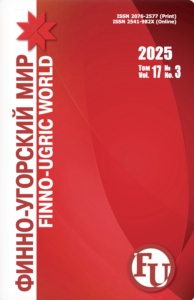Original article
DOI: 10.15507/2076-2577.014.2022.02.160-170
Representation of the morbid state of a person in the phraseology of Russian and Mordovian dialects on the territory of the Republic of Mordovia
Alina Yu. Maslova
Tatiаna I. Mochalova
Mariiа Z. Levina
National Research Mordovia State University,
Saransk, Russia
Introduction. The paper considers phraseological units that characterize the morbid state of a person in Russian and Moksha dialects on the territory of the Republic of Mordovia. The purpose of the study is to present the semantic characteristics of dialect phraseological units, analyze their component composition, and identify axiological and cultural-historical ideas of dialect speakers in the region.
Materials and Methods. Various techniques and research methods were used in the work: a descriptive method, a comparative method, a method of component analysis, a method of contextual analysis, a method of linguistic and cultural interpretation. The study was conducted on the material of phraseological dictionaries of Russian dialects of the Republic of Mordovia and the Mordovian (Moksha and Erzya) languages.
Results and Discussion. The study found that in the Russian and Moksha dialects of the Republic of Mordovia there are stable combinations known from ancient times, which name diseases and their symptoms, various painful conditions of a person. It was revealed that the languages of different types use phraseological units, which include somatisms, zoonyms, phytonyms, names of various objects, which reflects the features of a person’s figurative thinking, associative perception of the surrounding reality. A comprehensive study of phraseological units that characterize the morbid state of a person in the languages of different types on the territory of one region contributes to the comprehension of folk mentality, revealing the specifics of the national linguistic picture of the world of the Russian and Mordovian peoples, and allows us to trace the general and specific features of the linguistic community.
Conclusion. The results of the study indicate that phraseological units are actively used in the compared dialects of the Russian and Moksha languages, denoting a person’s morbid condition and representing the characteristic features of the image of the disease in different cultures.
Keywords: phraseology, phraseosemantic group, phraseological unit, meaning, dialects, Moksha language, Russian language, comparison, disease, nomination
For citation: Maslova AYu, Mochalova TI, Levina MZ. Representation of the morbid state of a person in the phraseology of Russian and Mordovian dialects on the territory of the Republic of Mordovia. Finno-ugorskii mir = Finno-Ugric World. 2022;14;2:160–170. (In Russ.). DOI: 10.15507/2076-2577.014.2022.02.160-170.
Information about the authors
A. Yu. Maslova – Doctor of Philology, Professor, Department of the Russian Language, National Research Mordovia State University, al_mas@mail.ru, https://orcid.org/0000-0002-9367-1473
T. I. Mochalova – Cand. Sc. {Philology}, Associate Professor, Department of the Russian Language, National Research Mordovia State University, mochalova2014@rambler.ru, https://orcid.org/0000-0003-1369-2985
M. Z. Levina – Сand. Sc. {Philology}, Associate Professor, Mordovian Languages Department, National Research Mordovia State University, lev.mariya@mail.ru, https://orcid.org/0000-0002-7808-2187






















